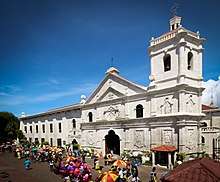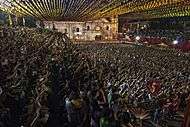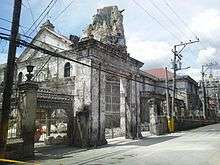Basilica del Santo Niño
The Basílica Menor del Santo Niño de Cebú (Minor Basilica of the Holy Child of Cebú), commonly known as Santo Niño Basilica, is a minor basilica in Cebu City in the Philippines that was founded in the 1565 by Fray Andrés de Urdaneta, O.S.A. and Fray Diego de Herrera, O.S.A.. The oldest Roman Catholic church in the country, it is built on the spot where the image of the Santo Niño de Cebú was found during the expedition of Miguel López de Legazpi. The icon, a statuette of the Child Jesus, is the same one presented by Ferdinand Magellan to the chief consort of Rajah Humabon upon the royal couple's christening on April 14, 1521. It was found by a soldier named Juan de Camuz forty years later, preserved in a wooden box, after Legazpi had razed a local village.[1] When Pope Paul VI made the church a basilica in 1965, he declared it to be "the symbol of the birth and growth of Christianity in the Philippines."[3]
| Minor Basilica of the Holy Child | |
|---|---|
| Basílica Menor del Santo Niño de Cebú | |
 Basílica Menor del Santo Niño de Cebú | |
.svg.png) Minor Basilica of the Holy Child Location in the Philippines | |
| 10°17′38″N 123°54′5″E | |
| Location | Cebu City |
| Country | Philippines |
| Denomination | Roman Catholic |
| Website | Official website |
| History | |
| Former name(s) | Church and Convent of Saint Augustine[1] |
| Status | Minor Basilica |
| Founded | April 28, 1565 |
| Founder(s) | Fray Andres de Urdaneta, O.S.A. Fray Diego de Herrera, O.S.A. |
| Consecrated | 1739[1] - 1740[2] |
| Relics held | Santo Niño de Cebú |
| Architecture | |
| Functional status | Active |
| Heritage designation | National Historical Landmark |
| Designated | 1941 |
| Architect(s) | Fray Juan de Albarran, O.S.A. |
| Architectural type | Church and convent |
| Style | Earthquake Baroque |
| Groundbreaking | 1735 |
| Completed | 1739–1740 |
| Specifications | |
| Number of spires | 1 |
| Materials | Stone[1] |
| Bells | 7 (6) |
| Administration | |
| Archdiocese | Roman Catholic Archdiocese of Cebu |
| Province | Augustinian Province of Sto. Niño de Cebu - Philippines |
| Clergy | |
| Rector | Rev. Fr. Pacifico C. Nohara Jr. O.S.A. |
The present building, which was completed from 1739–1740, has been designated by the Holy See as the "Mother and Head of all Churches in the Philippines" (Mater et Caput... Omnium Ecclesiarum Insularum Philippinarum).[4]
History
_(14594873197).jpg)
The church of the Holy Child was founded by Fray Andrés de Urdaneta, O.S.A. on April 28, 1565, the day when the image of the Holy Child was found in a partially burned hut. More than a week passed after the rediscovery of the image of Santo Niño, on May 8, 1565, Miguel Lopez de Legazpi initiated the founding of the first Spanish settlement in the Philippines. On the spot of the house where the image of the Santo Niño was found, the monastery of the Holy Name of Jesus was constructed.
The first church to be built on the site where the image of the Holy Child was found was burned down on November 1, 1566. It was said to be built by Fr. Diego de Herrera using wood and nipa. Fray Pedro Torres, O.S.A. started the construction of a new church in 1605. It was finished in 1626 but was again burned in March 1628. Fray Juan Medina, O.S.A.[5] started the construction of another church in 1628, using stone and bricks, a great innovation at that time. The construction was stopped because the structure was found to be defective.
Present church
On February 29, 1735, Father Provincial Bergaño, Governor-General Fernando Valdes, Bishop Manuel Antonio Decio y Ocampo of Cebu and Fray Juan de Albarran, O.S.A. started the foundations of the present church, using stone. Since the friars did not have the means to complete the church, they enlisted the help of the parishioners of Opon and San Nicolas to contribute materials, while the people of Talisay contributed labor. The lack of chief craftsmen and officers forced Fray Albarran to acquire some knowledge of architecture.[2]
The church was finished around 1739.
On January 16, 1740, the miraculous image was enthroned in the new Augustinian church.
In 1789, the church underwent a renovation. In 1889, Fray Mateo Diez, O.S.A. did another renovation. The original features of the church have been retained except for the windows which he added.
In the 1960s, both church and convent underwent a bigger restoration on the occasion of the Fourth Centennial of the Christianization of the country. The face lifting was made with utmost respect for the historical character of the old structure.
In 1965, Ildebrando Cardinal Antoniutti, Papal Legate to the Philippines, conferred the church the honorific title Basílica Menor upon the authority of Pope Paul VI. As a Minor Basilica, it is given precedence over other churches and other privileges. Philippine President Ferdinand E. Marcos also declared it a National Landmark.
The Basilica del Santo Niño remains under the care of the Augustinian Friars.
Pilgrim Center
The devotees kept increasing over the years and could easily fill the Basilica. To accommodate this growing number of devotees who come to hear mass in the Basilica, a pilgrim center was built within the church compound opposite of the Basilica and Holy Mass is celebrated on Fridays and other Religious Festivities are held here in the open-air, theater-like structure.
Completed in September 1990, this open-air structure can accommodate 3,500 people. The basement of the Pilgrim's Center houses the Basilica Del Sto. Niño Museum.[1]
2013 Bohol earthquake
On October 15, 2013, at approximately 8am GMT+8, a 7.2-magnitude earthquake shook Tagbilaran, Bohol, its force felt throughout the Visayas. It caused more than 120 casualties, and much damage to buildings, historical landmarks and churches. The earthquake destroyed most of the Basilica's belfry and façade; some walls and frescoes were cracked. A video of the collapse can be seen here. The building was soon restored and later re-opened to the public. The bell tower is now fully reconstructed and the main door of the church as well as the area in between the original church and the pilgrim center is now fully accessible.
Museum
The museum was first established in the year 1965 by Fr. Ambrosio Galindez, O.S.A. for the purpose of the commemoration of the Fourth Centennial of the Christianization of the Philippines. It was then located at a certain room in the convent. Old church documents dating back to the 17th century, antique church furniture, antique church things (i.e. Chalice, Altar Table, Thurible, etc.), and antique vestments of the priests are in display. The old vestments of the Sto. Niño de Cebu dating back to the 17th century are also in display. The relics and statues of the different saints are also in exhibit. The replicas of the Sto. Niño used in different pilgrimages in the Philippines and abroad are displayed. Some donated jewelleries and gift toys to the Sto. Niño are in display also.
The Basilica del Sto. Niño Museum is currently located at the basement of the Pilgrim Center.
Basilica del Santo Niño Library
Originally for exclusive use by the friars, in the year 2000 the church library was opened to all serious nonclerical researchers. Its collection covers religious subjects and non-religious disciplines including history, science, philosophy, Filipiniana, and periodicals.[1]
Designation
The Church and Convent of Santo Niño was declared a National Historical Landmark in 1941.[2]
In 1965, Pope Paul VI declared the basilica to be "the symbol of the birth and growth of Christianity in the Philippines."[3] In his pontificate, the ecclesiastical document Ut Clarificetur designated the basilica as the "Mother and Head of all Churches in the Philippines" (Mater et Caput... Omnium Ecclesiarum Insularum Philippinarum).[4]
Location
The Basílica Menor del Santo Niño de Cebu Basilica Complex is located in city block bordered by Osmeña Boulevard, D. Jakosalem St, P. Burgos St. and the Plaza Sugbo where the Magellan's Cross is located. The main entrance is on Osmeña Boulevard. Two blocks north of the basilica is the Cebu Metropolitan Cathedral, the seat of the Roman Catholic Archdiocese of Cebu.
Gallery
 Interior of the Basilica del Santo Niño
Interior of the Basilica del Santo Niño- The frescoes on the ceiling of the Basilica
 Inside the Basilica
Inside the Basilica Candle lighting for prayer at the Sto. Niño Church
Candle lighting for prayer at the Sto. Niño Church Mass celebrated at the Pilgrim Center in front of the Basilica
Mass celebrated at the Pilgrim Center in front of the Basilica After the 2013 Bohol earthquake.
After the 2013 Bohol earthquake.
References
- "Basilica Complex". Basilica del Santo Niño. Retrieved on 2013-01-30.
- "About the Basilica"
- "Archived copy". Archived from the original on 2013-03-03. Retrieved 2014-07-18.CS1 maint: archived copy as title (link)
- "Archived copy". Archived from the original on 2013-03-02. Retrieved 2014-09-10.CS1 maint: archived copy as title (link)
- "Administration". Basilica del Santo Niño. Retrieved on 2013-01-30.
External links
| Wikimedia Commons has media related to Basilica of Santo Niño (Cebu). |